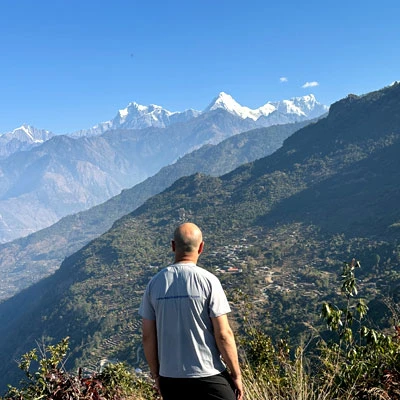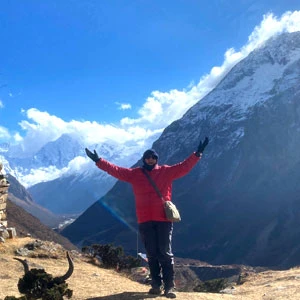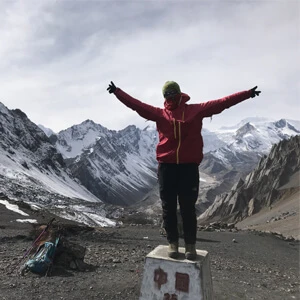There is an old saying, "If only every celebration had a holiday—yes, you read that right—there would be 365 days off in Nepal. Political unrest and strikes frequently make one wonder how things get done in Nepal. Nepal is a multiethnic country with more than 60 different ethnic communities, and practically every one of them speaks their own unique language. It is a nation known for its celebrations and festivals that are tied to social, religious, and traditional events. Nepal is known as the "heaven for trekkers" because of its stunning mountains, winding roads, and lush meadows, but it's also a fantastic destination for colorful and enjoyable festivals. Explore Nepal during one of these great festivals if you want to discover the traditions and culture of the country. Numerous festivals that are commemorated in Nepal showcase the country's vibrant cultural variety. Here are the 10 biggest festivals in Nepal to give you a better idea of the country's variety. Furthermore, Nepal is known as the home of adventure, natural beauty, and cultural paradise. Combining festivals with trekking in Nepal adds real value to your journey. You may see below how to combine festivals and adventurous activities in Nepal to have a better vacation.
Top 10 Festivals in Nepal
Experience the festivals in NepalTop 10 Biggest Festivals in Nepal
- Dashain
- Tihar(Dipawali, Yama Panchak)
- Magheshakranti
- Maha Shivaratri
- Holi- Festival of Colors
- Bisket Jatra- Newari Festival
- Tiji / Tenchi festival in Upper Mustang
- Janai Purnima (Rakshya Bandhan)
- Indra Jatra/Kumari jatra- Worshiping for good harvest
- Teej- The women’s festival
Dashain-One of the Biggest Festival of Hindu
Dashain, a 15-day celebration, is not only the nation's longest festival but also its most anticipated. The fall, roughly between September and October, is also regarded as the best season for hiking in Nepal. The celebration honors the triumph of truth over lies and good over evil in Goddess Durga's nine manifestations. This is a yearly celebration in Nepal where families come together to enjoy fifteen days of happiness, goodness, traditional foods, and time spent interacting with the elderly. During this time, families attend the festival while returning to their original houses. Kids fly kites while receiving tika blessings. Goddess Durga is revered with tremendous fervor since she is the true embodiment of strength, bravery, cruelty towards vices, and many other virtues. Additionally, it is a time to remember the memorable occasion when Lord Ram killed Ravan. On the eighth day, it's common to see animal sacrifices with male goats, ducks, chicks, eggs, and coconuts. With the blessings of their elders, people put a mixture of rice and a red powder called Tika and Jamara on their foreheads. Do keep in mind that transportation often fills up in the days leading up to the holiday. On the main day, the Taleju temple in Kathmandu's Durbar Square and many more open quite early. Regular tourist services will continue to be provided.
Highlights of Dashain Festival:
- Ghatasthapana: Holy Jamara Sowing at Dashain Ghar
- Fulpati: Sacred flowers, water, and banana stalks are presented.
- Asthami: offering sacrifices to Kali and Durga
- Navami
- Vijaya Dashami: Tika and blessings from elder family members
Recommended Treks:
- Manaslu Circuit Trek
- Everest Base Camp Trek
- Annapurna Base Camp Trek
- Langtang Valley Trek
- Kanchenjunga Circuit Trek

Tihar (Dipawali)-The Second Biggest Festival of Hindu
After two weeks of Dashain, Tihar (Dipawali), a five-day festival and Nepal's second-most significant celebration after Dashain, begins. Tihar is a Hindu festival honoring numerous Hindu deities, such as Lakshmi, Yamaraj, and Yamuna. People honor not just the gods but also the animals and birds that have strong ties to them. The Hindu festival of Tihar lasts for five days, during which time the four creatures connected to the Hindu god of death, Yama, are celebrated and worshipped. The final day is dedicated to people. The celebration is said to start with Kaag (crow) Tihar on Trayodashi of Kartik Krishna Paksha and end with Bhai (brother) Tika on Dwitiya of Kartik Sukla Paksha every year, according to the Vikram Samvat calendar. The fifth day, referred to as Bhai-tika (Brother's Day), is when brothers and sisters trade tikas. Sisters and brothers gather on the day of Bhai Tika to exchange tika (colorful remarks on the forehead) with one another. On this day, brothers and sisters commemorate one another, and each sister prays to the gods and goddesses for her brother to live long and prosper. On this festival you can witness vibrant holiday lights, welcoming Lakshmi, the goddess of wealth. Towns and villages are all illuminated with dazzling lights, and patterns drawn with flower petals and colored rice, and people revere dogs for their devotion by giving them garlands and tasty treats. Crows, dogs, cows, and bullocks are just a few of the animals that will be honored during this festival. Kathmandu would be a great choice if you want to enjoy an entirely true experience of the city, replete with worshiping the gods and goddesses, experiencing the bright-lit lights, and all the other customs.
Dipawali Highlights:
- Crow Worship at Kaag Tihar
- Kukur Tihar, a Nepali dog festival
- Cow Worship and the Worship of Goddess Lakshmi
- Worship of elders, oneself, and cow dung during the Goru Pooja, Maha Pooja, and Govardhan Pooja
- Brother's Day of Prayer
Recommended Treks:
- Tsum Valley Trek
- Ghorepani Poon Hill Trek
- Everest Three High Passes Trek
- Upper Mustang Trek
- Upper Dolpo Trek

Magheshakranti
The date of Maghe Sankranti is determined by the northward journey of the winter sun, making it one of the few Nepalese festivals that are not linked with the lunar calendar. Maghe Sankranti is comparable to solstice festivities in many other traditions since it marks the day the sun departs from its southernmost point and embarks on its northward journey. Mid-January is usually when it happens. The festival seeks to announce the end of winter and the beginning of spring. Lord Vishnu, God is honored on this day for his endeavors. People take holy baths in the Holy River, the housewife wishes for the health of the entire family, and auspicious foods like sesame seed laddus, molasses, ghee, sweet potatoes, and yams are given out. Early in the morning, people frequently visit the temple of the Hindu god Vishnu and offer him food, incense, and flowers. They read the Bhagavad Gita, sometimes referred to as the Gods' Song. Sankhamul on the Bagmati near Patan; Triveni in the Gandaki/Narayani River basin; Devghat close to the Chitwan Valley; Ridi on the Kaligandaki; and Dolalghat on the Sun Koshi in the Koshi River basin. It would be a wonderful choice to go on this day.
Magheshakranti Festival Highlights:
- Visit Sankhamul on the Bagmati River in Kathmandu
- Visit Triveni, Devghat, Chitwan
- Visit the Koshi River at Dolalghat
Recommended Treks:
- Mardi Himal Trek
- Pikey Peak Trek
- Short Annapurna base Camp Trek
- Everest View Trek
- 3 Day Chisapani Nagarkot Trek
Maha Shivaratri:
One of the most well-known holidays honoring the Hindu deity Lord Shiva, who according to Hindu mythology is the supreme god, is Shivaratri. Shivaratri, which stands for triumph, sincerity, and forgiveness, is observed nationwide in Nepal. Some of the best and most important Shiva-related locations are found in Nepal, such as the Pashupatinath Temple, which passionate followers swear to visit at least once in their lifetimes. According to the Hindu lunar calendar, Shivaratri is observed on the fourteenth day of the Magha month. It is the auspicious month's new moon day. Devotees throng Shiva temples on this day early in the morning. People who worship Shiva observe fasts day and night. They carried out several rituals on this day by pouring milk and performing the Rudra Abhishek over the Shiva statue. On the eve of Shivaratri, more than a million people visit the Pashupatinath Shrine in Kathmandu, the largest temple in the world devoted to Lord Shiva. Among Hindus, it is one of the most sacred shrines. Visitors from all over the world congregate here to see the strange Sadhu Babas worshipping Lord Shiva while they are in a state of meditation. The Kathmandu Valley and all of Nepal are guarded and protected by Pashupatinath, who is highly venerated.
Shivaratri Highlights:
- Visit Pashupatinath temple
- Aghora, Sadhus, and Sanyasis devotees dressed as Lord Shiva
- Marijuana is used in a temple to appease the god.
Recommended Treks:

Holi-Festival of Colors:
One of Nepal's most well-known holidays among international visitors is probably Holi, Hori, or Fagun Purnima since it is so full of joyous colors, goodwill, and love. People assemble and color each other as a show of appreciation. On the first day, Fagu Purnima is observed in the Hilly region and Mountain region, while Holi is observed in the Terai region on the second day in Nepal. Locals also mark the beginning of the Holi festival by placing a bamboo pole called a "chir" that has been decked with colorful fabric strips to signify luck and wealth. People also gather firewood and build bonfires to commemorate Holika's demon-killing attempt on Vishnu during Fagu Purnima. People ignite bonfires as part of the festivity to commemorate the demon Holika's passing. Holi is celebrated by using dry paint, water sprays, water cannons, balloons, and a special meal at night. Foreign visitors will now receive preferential treatment. Please leave the camera at home and avoid carrying any valuables outside unless they are bagged up in plastic. Also, wear white clothing if you go out on this day.
Every year, the Holi festival is held in late February or early March. The festival marks the start of Nepal's second busiest trekking season, Spring. The Holi festival may be the best excuse to celebrate with the locals while also combining trekking and tours in the breathtaking Himalayas. So, in addition to the most popular Holi festival, here are some highly recommended treks for those adventure seekers.
Holi Festival Highlights:
- Visit Basantapur, Kathmandu
- Playing with colors and water guns with the locals
- Victory over evil
- Exchanging love and happiness
Recommended Treks:
- Everest Base Camp with Gokyo Valley Trek
- Mohare Danda Trek
- Manaslu Circuit Upper Route
- Gokyo Valley Trek

Bisket Jatra- Newari Festival:
Beginning around the middle of April, during the Nepali Baishakh month, comes Bisket Jatra, also known as the Nepal New Year Festival. This is one of the biggest festival of Newar community. The main activity to observe this national holiday is the Bisket Jatra chariot parade in Bhaktapur. Additionally, it's one of Nepal's most thrilling annual events, drawing visitors from all over the world. This massive gathering is held in Bhaktapur at the start of Nepali Bisket Month. Serpents come to an end with Bisket Jatra. The festival of Bisket Jatra includes a sizable rally and a tug-of-war, and locals participate in customary festival activities like singing, dancing, playing with colors, and tongue piercing. The event culminates in a chariot war in Bhaktapur's Khalna Tole as a massive chariot pulling the god Bhairab is dragged through the streets. In the Bhaktapur regions of Thimi and Balakhu, tourists are welcome to participate in the demonstration with residents, sing, dance, play the dhimay, and hurl colored powder at one another. During Bisket Jatra, tongue piercing ceremonies are quite popular.
Bisketjatra Highlights:
- Visit Bhaktapur Durbar Square
- Visit Patan Durbar Square
Recommended Treks:
- Manaslu Circuit with Tsum Valley Trek
- Kanchenjunga Circuit Trek
- Everest Three High Passes Trek
- Upper Dolpo Trek
- Annapurna Circuit with Tilicho Lake Trek

Tiji/Tenchi festival in Upper Mustang
Tiji festival is known as Tenji festival. The major Tibetan-Buddhist celebration known as the Tiji Festival is observed in Lo-Manthang City in Upper Mustang. The celebration is still endemic to Upper Mustang residents, which was established more than 300 years ago to commemorate the triumph of good over evil. The festival explores the folklore around Tibetan Buddhist figures Dorje Jono and Padmasambhava Guru Rinpoche. Dorje Jono is a popular Vajrayana Buddhist deity who carried out Padmasambhava's directive and defeated evil forces to bring prosperity. The celebration performs a protracted ritual that includes prayer chants and vibrant mask dances. The dances recreate the conflict between Dorje Jono and the evil forces in historical times. Upper Mustang Trek with Tiji festival would be bonus and a lifetime experience for travelers. It is located near the Tibetan border in the north.
Tiji Festival Highlights:
- Tiji Festival
- Visit Lo-Manthang
- Explore the unspoiled Tibetan community and culture
- Lose with a unique and isolated Upper Mustang

Janai Purnima - Rakshya Bandhan
The Sacred Thread Festival is known as Janai Purnima, and it is when Hindu men, particularly Brahmins, and Chettris, undertake their yearly Janai change ritual. Everyone who participates in this celebration wraps a sacred thread around their wrist and chest on the full moon day of the fourth month of the Nepali calendar, which is August/September. The center of the event, Gosaikunda, a sacred pond at a high elevation, is a hive of color and bustle on this day. People travel to numerous holy sites on this day. The Gosaikunda walk is the most captivating to tourists out of all of them.
Janai Purnima Highlights:
- Visit Gosaikunda Lake
- Visit Khayar Lake
Recommended Treks:

Indrajatra/Kumari jatra-Worshiping for good harvest
One of the most thrilling and revered celebrations of the Newari population of the Kathmandu Valley is Indra Jatra, also known as Yenya, which takes place during the Nepali month of Bhadra and lasts for eight days. The Indra Jatra celebration is held to honor the dead from the previous year and to ask Indra and Dagini for a healthy harvest. In reality, the Yenya Festival is divided into two events: the Indra Jatra and the Kumari Jatra. The flagpole ceremony, blood sacrifices, and displays of Bhairava's masks will be witnessed. The live goddess will ride in the chariot through the streets of Kathmandu during the Kumari Jatra. A wooden pole made of pine is erected at Basantapur Square, in front of the former Hanuman Dhoka Palace, to signal the start of the Jatra. Additionally, the Living Goddess Kumari's chariot is brought out and paraded around Kathmandu's streets. Thousands of people gather to watch the joyful procession led by the Lakhey, mask-wearing dancers. If you're visiting Kathmandu for the first time during Indrajatra, go to the festival's main location, the Durbar Square, and have some raksi, a typical Nepalese alcoholic beverage, as well as take in some masked dance performances.
Indrajatra Highlights:
- Visit Kathmandu's Hanuman Dhoka and the Living Goddess Kumari.
- Visit the ancient city of Kathmandu Valley.
- Raksi, a typical Nepalese alcoholic beverage
Recommended Treks:

Teej- The Women’s Festival in Nepal
The Teej festival is dedicated to the biggest gods of Hinduism, Shiva, and Pravati. The festival of Teej, also known as the Festival of Women, is specially celebrated in Pashupatinath and runs from the second to the fifth day following the new moon in the month of Nepali Bhadra (September). Nepalese women dress in their stunning red saris, colorful bangles, and heavy jewelry on this day. Married ladies traditionally visit their mothers' houses and feast on traditional dinners known as dar, which hold great significance for them. At the Teej festival, women cook a variety of delicious meals and enjoy their dinners with family before beginning their fasting. The fast is observed as a kind of self-purification and a prayer for the good health and longevity of the husband. For those who are not married, they wish to get a husband as a Shiva. Travelers can witness large groups of ladies dancing and singing in the alleys, chowks, and temples. On this day, we recommend visiting Pashupatinath Temple and Basantapur Durbar Square to explore deeply and enjoy them.
Teej Festival Highlights:
- Visit Pashupatinath Temple
- Visit Basantapur Durbar Square
Recommended Treks:

FAQs for festivals in Nepal:
People may have curiosity regarding the culture and festivals while visiting such a diverse country as Nepal, and combining the festivals on your journey will thrill your experience.
1. What is the biggest festival in Nepal?
Dashain is the biggest festival in Nepal.
2. What are the main festivals in Nepal?
Dashain, Tihar (Dipawali), Chhath, Lhosar, Shivaratri, Holi (festival of colors), Indra Jatra, Bisket Jatra, Tiji, Janai Purnima, and Teej are the main festivals in Nepal.
3. Which is the biggest Hindu festival in Nepal?
Dashain is the biggest Hindu festival in Nepal.
4. What is the best time to visit festivals in Nepal?
The biggest festivals are in October and November. However, there are so many other festivals that keep going on the rest of the month.
5. What is the biggest holiday in Nepal?
Dashain is the biggest holiday in Nepal. It lasts for 15 days.
For more details drop us a few lines. Our experts will get back to you soon.







